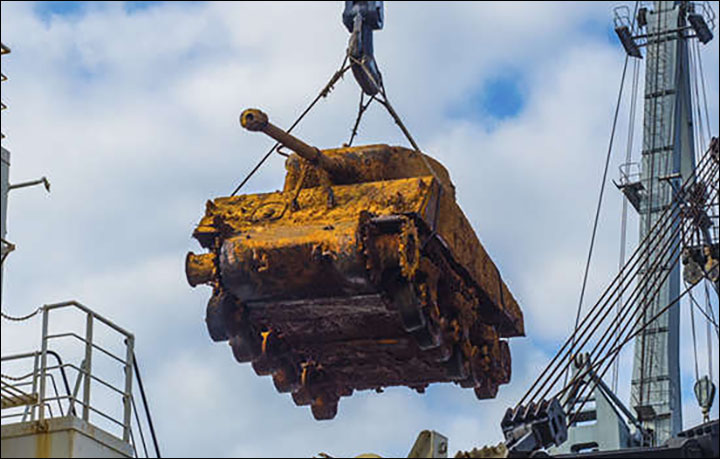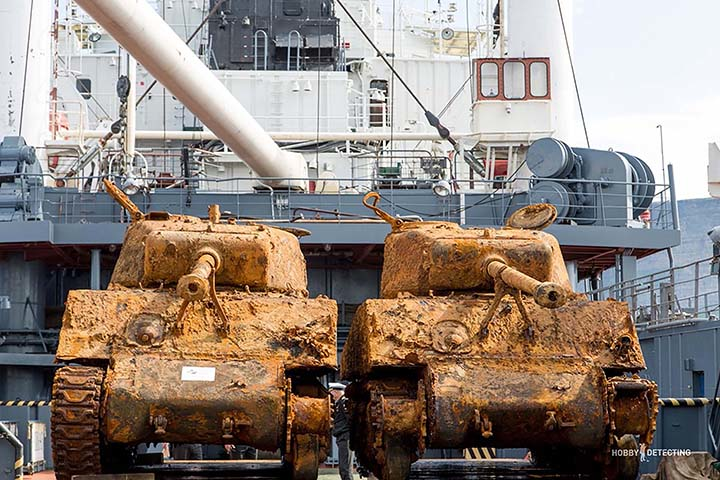This week local Siberian press reported that a rusting Sherman tank dating from WW2 was airlifted all the way across Russia for use in a major military parade.
Around 4,000 of such tanks were brought to the Soviet Union under the Lend-Lease program, to boost Stalin’s firepower to defeat the Germans. A total of 22,800 armored vehicles were supplied by Lend-Lease to the Red Army during the war, of which 1,981 were lost at sea on the one or other dangerous Arctic convoy .
The tank flow over Russia had sank to the bottom of the cold northern Baren Sea when the Thomas Donaldson cargo ship was torpedoed by a German U-boat in March 1945. One officer and three crew members perished in the torpedo attack, while the rest of its 68 officers and crew were rescued by British vessels in the convoy carrying equipment to bolster the Soviet war effort.
The wreck was discovered 13 years ago lying at a depth of about 55 meters. Over the past two years, divers have been on a mission to recover its cargo and bring it to shore for restoration.
Three tanks from the wreck of the Thomas Donaldson were brought to the surface last year.
One of these tanks has already been restored and became a part of a historical platoon in Russia’s Northern Fleet. Another will be featured in the St Petersburg Victory Day parade on May 9, commemorating the defeat of the Nazis.
The third one was flown east on an Ilyushin-76 transport plane over seven time zones from the Arctic region of Murmansk to a military airport near Vladivostok on the Pacific coast. Here is the video, which shows the tank being unloaded in the Russian Far East after its epic flight.
https://www.youtube.com/watch?time_continue=1&v=EDrr9xi9YDI
The tank will be faithfully restored before taking a part in the Vladivostok’s Victory Day parade on May 9.
According to Wikipedia (https://en.wikipedia.org/wiki/Lend-Lease)
“The lend-lease policy, formally titled “An Act to Promote the Defense of the United States”, was a program by which the United States supplied Free France, the United Kingdom, the Republic of China, and later the Soviet Union and other Allied nations with food, oil, and materiel between 1941 and August 1945. (…) A total of $50.1 billion (equivalent to $681 billion presently) was involved, or 11% of the total war expenditures of the U.S.”
Of these expenditures $11.3 billion (equivalent to $154 billion today) went to the Soviet Union.
By the beginning of 1943, 6,179 Lend-Lease tanks had been received in Russia since 1941. By 1945, with a major influx of American M4A2 Sherman medium tanks, some Russian tank corps and mechanized corps were equipped entirely with this tank type.
Far more critical to the Soviet war effort was the supply of tactical vehicles from the United States. During the war, Russia produced only 343,624 cars and lorries due to the heavy commitment of major automobile factories like GAZ to armored vehicle production. The USA provided the Russians with 501,660 tactical wheeled and tracked vehicles, including 77,972 jeeps, 151,053 1-1/2-ton trucks, and 200,622 2-1/2-ton trucks.
Jeeps were produced by Willis MB, trucks by Studebaker. During the war and right after the war these vehicles were practically the only vehicles of these types in Russia. The Russian produced a tenth as many Jeeps than the American produced. As a small kid I was sure that Studebaker was the name of all big trucks and all jeeps were called Willies. Of cause we kids didn’t know that these names were American. And I have a feeling that a lot of grown up Russians didn’t know it either.
I also remember very well the American food of my early childhood.
Due to the forced retreat of the Red Army in 1941-1942, the total sown area of USSR reduced by 41.9%, while the number of collective and state farms dropped by almost 40%. At least 19.5 million men – farmers, mechanics andtechnicians were called up for military service and industrial sector in 1941-
Mainly women, old people and adolescents continued working on farmsand fields.
The most nutritious product in our wartime menu: egg powder, condensed milk and milk powder. All American. The most popular meat product was called “Tushonka”: canned chunks of pork with lard seasoned with bay leaves and other spices. (Spam?) American “Tushonka” was good hot or could be served cold right from the can. I still remember taste of this best “delicacy” of my childhood.
After the war Soviet sources of information rarely mentioned American help.
The Soviet Marshal Georgy Zhukov in a confidential interview with the famous writer and wartime correspondent Konstantin Simonov said:
“Today some say the Allies didn’t really help us… But listen, one cannot deny that the Americans shipped over to us material without which we could not have equipped our armies and couldn’t be able to continue the war.”
Nikita Khrushchev, having served as a military commissar and intermediary between Stalin and his generals during the war, addressed directly the significance of Lend-lease aid in his memoirs:
“I would like to express my candid opinion about Stalin’s views on whether the Red Army and the Soviet Union could have coped with Nazi Germany and survived the war without aid from the United States and Britain. First, I would like to tell about some remarks Stalin made and repeated several times when we were “discussing freely” among ourselves. He stated bluntly that if the United States had not helped us, we would not have won the war.”
Today majority of Russians know nothing about American help to the USSR in the WWII.
I found the information about the Sherman tank transported across Russia for participation in the Vladivostok’s Victory Day celebration in the local Siberian press. National Russian press hadn’t covered this event.
EDITOR’S NOTE: According to Wikipedia, the Soviet Union suffered up to 11,400,000 deaths. The United State lost 407,300. [153]



